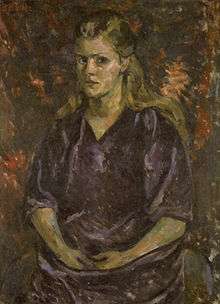Anna Mahler
| Anna J. Mahler | |
|---|---|
 Anna Mahler by Broncia Koller-Pinell, 1921 | |
| Born |
15 June 1904 Vienna, Austria |
| Died |
3 June 1988 (aged 83) Hampstead, London, England, United Kingdom |
| Resting place | Highgate Cemetery, London, England, United Kingdom |
| Nationality | Austrian |
| Known for | Sculpture |
| Spouse(s) |
Rupert Koller (1920 – 1921) Ernst Krenek (1924 – 1924) Paul Zsolnay (1929 – 1934) Anatole Fistoulari (1943 – 1956) Albrecht Joseph (ca. 1970 – ) |
Anna Justine Mahler (15 June 1904 – 3 June 1988) was an Austrian sculptor.
Early life

Born in Vienna, Anna Mahler was the second child of the composer Gustav Mahler and his wife Alma Schindler. They nicknamed her 'Gucki' on account of her big blue eyes (Gucken is German for 'peek' or 'peep'). Her childhood was spent in the shadow of her mother’s love affairs and famous salon. Anna also suffered the loss of her older sister Maria Mahler (1902–1907) who died of scarlet fever when Anna was two—and her father, who died when she was six. The aftermath of both tragedies resulted in her mother's love affair with the German architect Walter Gropius and her stormy relationship with the Austrian Expressionist painter Oskar Kokoschka. Alma Mahler's second marriage to Gropius, however, provided some semblance of family life during Anna’s adolescence—as well as a half-sister, Manon Gropius (1916–1935).
Anna was educated by tutors and also enjoyed the attention of her mother's friends, which included many of the important artistic figures in music, the visual arts, and literature. As the daughter of the legendary Gustav Mahler, Anna was expected to have a musical career. However, rather than being a professional musician, Anna fell in love with one, a rising young conductor, Rupert Koller.
Personal life
The marriage, which took place on 2 November 1920, when Anna was only sixteen, ended within months. Soon after, Anna moved to Berlin to study art. While there, she fell in love with Ernst Krenek the composer, who later was asked by Alma to produce a neat copy of two movements from the draft of Mahler’s unfinished Tenth Symphony. Anna married him on 15 January 1924, but that marriage too failed, and she left Krenek for good in November 1924. During this time, Krenek was completing his Violin Concerto No. 1, Op. 29. The Australian violinist Alma Moodie assisted Krenek with getting financial assistance from her Swiss patron Werner Reinhart (at whose instigation Krenek and Mahler were living in Zürich) and, in gratitude, Krenek dedicated the concerto to Moodie, and she premiered it on 5 January 1925, in Dessau. Krenek’s divorce from Anna Mahler became final a few days after the premiere.[1] Krenek did not attend the premiere, but he did have an affair with Moodie[2] which has been described as "short-lived and complicated".[3]
She married the publisher Paul Zsolnay on 2 December 1929, and they had a daughter, Alma (5 November 1930 – 15 November 2010). The couple divorced in 1934.
April 1939 found her living in Hampstead in London and advertising in the newspaper for pupils, having fled Nazi Austria. On 3 March 1943 she married the conductor Anatole Fistoulari with whom she had another daughter, Marina (born 1 August 1943).
After the War, she travelled to California and lived there for some years. While married to Fistoulari, but separated, she appeared on the 2 January 1952 radio quiz show (and the 3 January 1952 TV edition) "You Bet Your Life." The marriage was dissolved around 1956.
Around 1970 she married her fifth husband, Albrecht Joseph (1901–1991), a Hollywood film editor and writer of screenplays. After her mother died in 1964, Anna, now financially independent, returned to London for a while before finally deciding to live in Spoleto in Italy in 1969.
Mahler once said that she had found true love with her last husband but had left him at the age of seventy-five in order that they might both progress, since they spent too much time looking after each other.
In 1988 she died in Hampstead, while visiting her daughter Marina there. She is buried at Highgate Cemetery.
Artistic career

Anna Mahler's exposure to the visual arts began early when she would visit Oskar Kokoschka's studio. She was also a model for her mother-in-law, the painter Broncia Koller-Pinell. After her divorce, Anna studied art and painting on and off in Berlin, Rome, and Paris throughout the 1920s. At the age of twenty-six, she discovered that sculpture was the medium in which she could best express her creativity. Having taken lessons in sculpting in Vienna in 1930 from Fritz Wotruba, she became an established sculptor there, and was awarded the Grand Prix in Paris in 1937.
As well as sculpting successfully in stone, Anna Mahler produced bronze heads of many of the musical giants of the 20th century including Arnold Schönberg, Alban Berg, Artur Schnabel, Otto Klemperer, Bruno Walter, Rudolf Serkin and Eileen Joyce.[4]
References
Footnotes
- ↑ Answers.com
- ↑ BBC Music magazine
- ↑ Kay Dreyfus, Alma Moodie and the Landscape of Giftedness
- ↑ Richard Davis, Eileen Joyce: A Portrait.
Sources
- Anna Mahler. Ich bin in mir selbst zu Hause Ed. by Barbara Weidle & Ursula Seeber (Weidle Verlag, Bonn, 2004)
- Anna Mahler tribute website
- Obituary, The Times, 6 June 1988